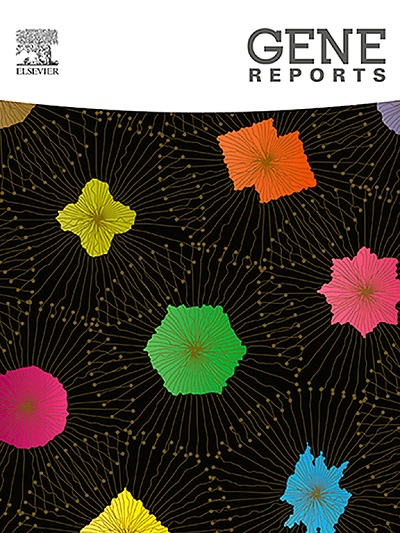The complete mitochondrial genome of Dama dama, and their phylogenetic relationships to other Cervidae
IF 1
Q4 GENETICS & HEREDITY
引用次数: 0
Abstract
This publication presents the complete mitochondrial genome of Dama dama along with in depth phylogenetic relationship and species divergence analysis in respect to other Cervidae. The mitochondrial genome presented here is 16,332 bp which is comprised of 13 genes, 2 rRNAs and 22 tRNAs. The mitochondrial genome for Dama dama is the smallest, compared to other Cervidae. Transfer RNA genes have a specific secondary structure, resembling a clover leaf, however, tRNASer (Serine 1) in Dama dama has been found to only have 3 arms, it is missing the dihydrouridine arm. The phylogenetic analysis conducted in this study compared the mitochondrial sequences from 25 different Cervidae species. Findings suggest that Dama dama, compared to other Cervidae, is most closely related to Dama mesopotamica and Megaloceros giganteus. With regards to Dama dama, the species divergence time from Dama mesopotamica and Megaloceros giganteus is 5.68 mya. Whereas the divergence time between Dama mesopotamica and Megaloceros giganteus is 5.35 mya. Our findings provide strong support for the distinction between Dama dama and Dama mesopotamica as a sub-species and a close evolutionary relationship between Dama mesopotamica and Megaloceros giganteus. Supporting previous reports of a sister-group relationship with a shared common ancestor. This study has provided a new perspective on the ancestral origin of the Dama genus, which can be further investigated using the Dama dama mitochondrial genome presented in this report. Understanding the evolution of Dama dama may help to better understand the lack of genetic diversity within the species and advance future management strategies to resolve this.
达马的完整线粒体基因组及其与其他鹿科动物的系统发育关系
本出版物介绍了达玛的完整线粒体基因组,以及与其他鹿科动物的深入系统发育关系和物种分化分析。本文介绍的线粒体基因组为 16,332 bp,由 13 个基因、2 个 rRNA 和 22 个 tRNA 组成。与其他鹿科动物相比,达玛的线粒体基因组最小。转运核糖核酸基因具有特殊的二级结构,类似于三叶草的叶子,然而,研究发现达玛-达玛的 tRNASer(丝氨酸 1)只有 3 个臂,缺少二氢尿苷臂。本研究进行的系统发生分析比较了 25 种不同的鹿科动物的线粒体序列。研究结果表明,与其他鹿科动物相比,达马与达马(Dama mesopotamica)和巨鹿(Megaloceros giganteus)的亲缘关系最为密切。Dama dama与Dama mesopotamica和Megaloceros giganteus的物种分化时间为5.68百万年。而 Dama mesopotamica 与 Megaloceros giganteus 的物种分化时间为 5.35 mya。我们的研究结果有力地支持了Dama dama和Dama mesopotamica作为一个亚种的区分,以及Dama mesopotamica和Megaloceros giganteus之间密切的进化关系。这也支持了之前的报道,即Dama mesopotamica和Megaloceros giganteus有着共同祖先的姊妹群关系。这项研究为达玛属的祖先起源提供了一个新的视角,可以利用本报告中介绍的达玛线粒体基因组进一步研究达玛属的祖先起源。了解达马的进化过程可能有助于更好地理解该物种缺乏遗传多样性的问题,并推进未来的管理策略以解决这一问题。
本文章由计算机程序翻译,如有差异,请以英文原文为准。
求助全文
约1分钟内获得全文
求助全文
来源期刊

Gene Reports
Biochemistry, Genetics and Molecular Biology-Genetics
CiteScore
3.30
自引率
7.70%
发文量
246
审稿时长
49 days
期刊介绍:
Gene Reports publishes papers that focus on the regulation, expression, function and evolution of genes in all biological contexts, including all prokaryotic and eukaryotic organisms, as well as viruses. Gene Reports strives to be a very diverse journal and topics in all fields will be considered for publication. Although not limited to the following, some general topics include: DNA Organization, Replication & Evolution -Focus on genomic DNA (chromosomal organization, comparative genomics, DNA replication, DNA repair, mobile DNA, mitochondrial DNA, chloroplast DNA). Expression & Function - Focus on functional RNAs (microRNAs, tRNAs, rRNAs, mRNA splicing, alternative polyadenylation) Regulation - Focus on processes that mediate gene-read out (epigenetics, chromatin, histone code, transcription, translation, protein degradation). Cell Signaling - Focus on mechanisms that control information flow into the nucleus to control gene expression (kinase and phosphatase pathways controlled by extra-cellular ligands, Wnt, Notch, TGFbeta/BMPs, FGFs, IGFs etc.) Profiling of gene expression and genetic variation - Focus on high throughput approaches (e.g., DeepSeq, ChIP-Seq, Affymetrix microarrays, proteomics) that define gene regulatory circuitry, molecular pathways and protein/protein networks. Genetics - Focus on development in model organisms (e.g., mouse, frog, fruit fly, worm), human genetic variation, population genetics, as well as agricultural and veterinary genetics. Molecular Pathology & Regenerative Medicine - Focus on the deregulation of molecular processes in human diseases and mechanisms supporting regeneration of tissues through pluripotent or multipotent stem cells.
 求助内容:
求助内容: 应助结果提醒方式:
应助结果提醒方式:


